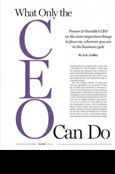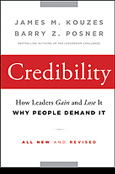July 2013: In This Issue
Entering the second half of 2013, your current year STRATEGY is either working or in need of revision. Full year financial forecasts are being validated or require updating. In all cases, mid course corrections should be under discussion to adjust to the unforeseen and changing competitive environment.
This issue of “A New Leaf” addresses the importance of your LEADERSHIP in driving organizational performance. Written by a leading CEO and a renowned management scholar, the references below highlight the unique components and key competency of the leadership role.
Improving your LEADERSHIP capabilities is a continuous journey. The success of your team depends upon your commitment to this process. Best of luck as you work to prioritize those leadership tasks that only you can perform and understand the importance of credibility in successfully performing them.
- Mike
 Feature Article: "What Only the CEO Can Do"
Feature Article: "What Only the CEO Can Do"
What is your unique role as CEO? What are the key tasks associated with the successful fulfillment of that role?
In "What Only the CEO Can Do," A.G. Lafley, the recently rehired CEO of Procter & Gamble (P&G), provides guidance to these and other key leadership questions. His perspectives are heavily influenced by his successes at P&G combined with his collaborations with Peter Drucker, the leading management scholar.
In clarifying what the unique work of the CEO is, Drucker believed that “The CEO is the link between the inside that is 'the organization' and the outside of society, economy, technology, markets and customers." Lafley elaborates on this linkage, stating that “it’s a job that only CEOs can do because everybody else in the organization is focused much more narrowly…. in one direction” either specifically outwardly or inwardly. “The CEO is the only one held accountable for the... results of the company” including both its own inside goals and those of diverse, often competing, outside constituencies.
Lafley defines the following four tasks as fundamental to the CEO fulfilling the critical “linkage” role:
Defining and interpreting the “MEANINGFUL OUTSIDE” for the company:
Every company has multiple stakeholders with competing demands. The CEO must decide “which constituency matters most, and which results are most important.” Drucker’s organizational premise is that “the purpose of a business is to create customers.” Only the CEO can define who that customer is and ensure that the organization acts on that understanding.
Deciding “what business you’re in and NOT in:"
The CEO must understand the attractiveness of the business you are currently in, your relative position relating to the competition, and the alignment of the industry’s needs with your company’s core competencies. This understanding must be translated to defining what you will do and what you will NOT do. “Only the CEO has the enterprise-wide perspective to make these tough choices.” Failing to choose results in leaders too often attempting to turn around a business even though it is not a sound strategic fit for the organization.
Balancing sufficient yield in the PRESENT with necessary investment in the FUTURE:
CEO’s “must work on the present to earn the right to invest in the future." It’s a balance that the CEO alone can strike, because only they are exposed to all the competing external and internal interests-while being accountable for the long term. Determining the optimal balance between yield from the present activities and investment in a highly uncertain future entails the riskiest choices a CEO can make. “It’s as much an art as a science.”
Shaping the VALUES and STANDARDS of the organization:
Values establish a company’s identity and drive behaviors that are measured by organizational standards. Drucker believed that “CEOs set the values, the standards, the ethics of an organization. They either lead or mislead.” Lafley furthers this premise in noting that “to sustain competitive advantage and growth, (the CEO) must create standards to ensure that the company wins with those that matter most and against its very best competitors.”
 Book Review: "Credibility-How Leaders Gain and Lose it-Why People Demand It"
Book Review: "Credibility-How Leaders Gain and Lose it-Why People Demand It"
Leadership Credibility. What is it? Do you have it? How do you develop it? What is necessary to sustain it?
While Lafley above sets forth WHAT the CEO needs to focus on, James Kouzes in “Credibility” addresses HOW a CEO must act to be successful. “Credibility” continues Kouzes’ leadership research first presented in his best seller “The Leadership Challenge,” which affirms that for any leader to be successful, they must be credible.
Kouzes defines successful leadership as the ability to create “willing followers.” This ability is directly impacted by credibility, which Kouzes defines as “doing what you say you will do.” Absent a leader successfully “walking the talk” and “living up to their commitments,” key constituents will be not become willing followers.
The following excerpts highlight Kouzes’ six disciplines integral to a leader sustaining their credibility:
Continuing a process of self discovery:
“Your ability to earn and sustain personal credibility depends, first and foremost, on how well you know yourself.” This includes continuous exploration and understanding of “your credo-the set of values and beliefs that serve as a guide to your decisions and actions, your competencies-the knowledge, skills and abilities you use to transform your words into actions and your confidence-the will to make use of those skills.” Understanding yourself is a prerequisite to helping others become successful; a necessary step in creating willing followers.
Appreciating constituents:
“A firm credibility foundation can be established only when you truly understand and appreciate - even embrace - the aims and aspirations of your constituents.” Leaders who are interested in their own agenda will not be followed willingly.
Affirming shared values:
“All members must align around shared values.” Effective leaders “build commitment to those values….in getting people to see themselves as part of a larger whole. Shared values are the foundation for building productive and genuine working relationships.”
Developing capacity:
Leaders must address the following five essential components to develop their capacity:
- Competence - they must have the knowledge and skill to “Do What They Say They Will Do”
- Choice - they must have the latitude to make choices based upon what they believe should be done
- Confidence - they must believe they can do it
- Climate - they need a culture that encourages risk taking and experimentation, accepting mistakes as a chance to learn from experience
- Communication - they must be constantly informed about what is going on in order to keep up to date.
Serving a purpose:
“Credible leaders serve a purpose and the people who have made it possible for them to lead. They put the guiding principles of the organization ahead of all else.”Employees will not “voluntarily follow self serving leaders whose goals are only to enrich themselves.”
Sustaining hope
“When leaders uplift spirits and restore people’s belief in the future, they strengthen their own credibility. In uncertain times, leaders with a positive, confident, can-do approach are desperately needed in business. Leaders must keep hope alive.”
Leaders that are closest to their constituents are constantly in a state of tension and struggle. In his final chapter, The Struggle to Be Human, Kouzes provides important guidance on challenges such as “when do I lead and when do I follow” and “what is the definition for leadership success.”
How are you doing in creating willing followers with your team? If you are feeling challenged, a full reading of “Credibility” may be your antidote.
©2013 See Change Management. All Rights Reserved. Site credit


